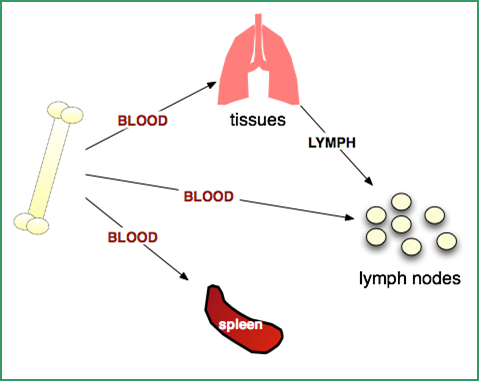BiteSized Immunology: Systems & Processes

Dendritic Cells: Migration
Introduction
Dendritic cells (DCs) (see footnote) can be found in three types of location within the body. They are present as ‘immature’ cells in peripheral tissues, especially tissues that are exposed to the external environment, including the skin, lungs and intestine. They are also present in lymphoid tissues, including the lymph nodes and spleen. To migrate to these locations, DCs travel via the blood or in lymph vessels. The primary function of DCs is to interact with lymphocytes and stimulate them, either to initiate or maintain an immune response against an infection, or to prevent responses against harmless foreign proteins (e.g. food or our normal helpful intestinal bacteria). In the lymphoid tissues DCs may exist in either the immature state, or as mature cells. Unlike T- or B cells, very few DCs migrate out of lymph nodes or the spleen; the vast majority of DCs die in the lymphoid tissues within a few days of their arrival. To understand DC migration, and the functions of the migrating DCs, it is helpful to consider the behaviour of the cells both in the absence of inflammation, the ‘steady state’, and after the immune system has been stimulated by an infection or other event.
Migration of DCs in the steady state
In the absence of inflammation many DCs migrate via the blood, as precursors, directly to the spleen and lymph nodes. The DC precursors can also migrate to peripheral tissues, where they may reside for many days, before travelling via the lymph to the local lymph nodes (Figure 1). DCs migrating from the tissue are able to carry proteins, acquired in the tissues, and ‘present’ them to T cells in the lymph nodes, to stimulate or tolerise the T cells. Tolerised T cells are prevented from responding to these proteins when they re-encounter them subsequently, and can also prevent other immune cells from responding to these proteins.

Migration of DCs in inflammation
When the immune system is activated, by an infection or other inflammatory stimulus, the functions of DCs change. Additional DCs are driven to migrate from the blood and tissues, and the DCs undergo a process of ‘maturation’. Mature DCs express higher levels of costimulatory molecules on their surface and are able to activate T cells, including T cells that have not previously been activated. These mature DCs play a central role in the initiation of T and B cell immune responses, and are therefore extremely important for defence against pathogens, and for the generation of immunological memory. Mature DCs may also express cytokines, including IL-12 and IL-23 that contribute to the polarisation of naive T cells.
Note: This article concerns ‘conventional’ DCs, not plasmacytoid DCs, follicular DCs or monocyte-derived DCs.
This article was updated in March 2021.
© The copyright for this work resides with the BSI
